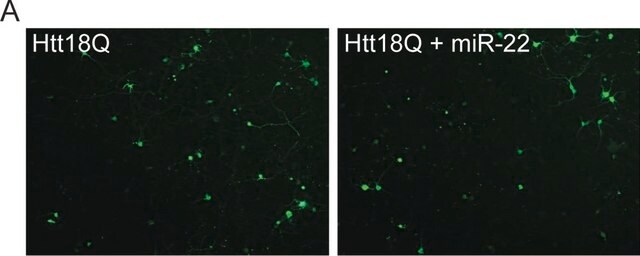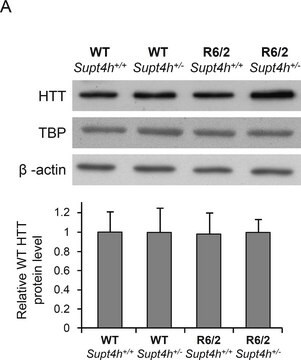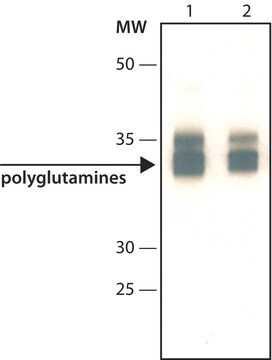Key Documents
H7540
Anti-Huntingtin (N-terminal) antibody produced in rabbit

affinity isolated antibody, buffered aqueous solution
Synonim(y):
Anti-HD, Anti-HTT, Anti-Huntington Disease, Anti-IT15
About This Item
Polecane produkty
pochodzenie biologiczne
rabbit
białko sprzężone
unconjugated
forma przeciwciała
affinity isolated antibody
rodzaj przeciwciała
primary antibodies
klon
polyclonal
Postać
buffered aqueous solution
masa cząsteczkowa
antigen ~110 kDa
reaktywność gatunkowa
mouse, human, rat
rozszerzona walidacja
recombinant expression
Learn more about Antibody Enhanced Validation
stężenie
~1.5 mg/mL
metody
western blot: 0.5-1.0 μg/mL using a HEK-293T cell lysate expressing a N-terminal fragment of human huntingtin
numer dostępu UniProt
Warunki transportu
dry ice
temp. przechowywania
−20°C
docelowa modyfikacja potranslacyjna
unmodified
informacje o genach
human ... HTT(3064)
mouse ... Htt(15194)
rat ... Htt(29424)
Opis ogólny
Zastosowanie
- in magnetic bead-assisted immunopurification
- in western blotting
- in immunofluorescent staining
- in immunoblotting
Działania biochem./fizjol.
Postać fizyczna
Oświadczenie o zrzeczeniu się odpowiedzialności
Nie możesz znaleźć właściwego produktu?
Wypróbuj nasz Narzędzie selektora produktów.
polecane
Kod klasy składowania
10 - Combustible liquids
Temperatura zapłonu (°F)
Not applicable
Temperatura zapłonu (°C)
Not applicable
Środki ochrony indywidualnej
Eyeshields, Gloves, multi-purpose combination respirator cartridge (US)
Certyfikaty analizy (CoA)
Poszukaj Certyfikaty analizy (CoA), wpisując numer partii/serii produktów. Numery serii i partii można znaleźć na etykiecie produktu po słowach „seria” lub „partia”.
Masz już ten produkt?
Dokumenty związane z niedawno zakupionymi produktami zostały zamieszczone w Bibliotece dokumentów.
Nasz zespół naukowców ma doświadczenie we wszystkich obszarach badań, w tym w naukach przyrodniczych, materiałoznawstwie, syntezie chemicznej, chromatografii, analityce i wielu innych dziedzinach.
Skontaktuj się z zespołem ds. pomocy technicznej







